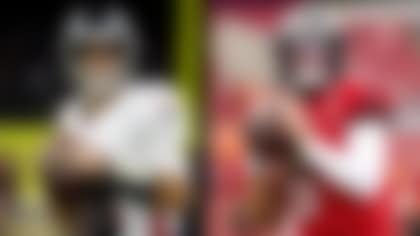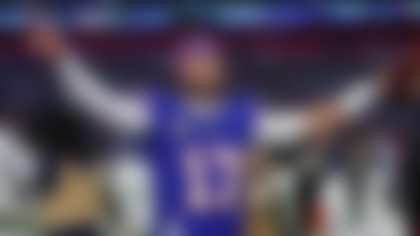Jackie Robinson and Kenny Washington stood shoulder-to-shoulder on the athletic fields of UCLA, as both excelled at football and baseball.
Yet they remain worlds apart in our nation's consciousness.
Major League Baseball celebrates Robinson every year on April 15 -- the date in 1947 when he broke baseball's longstanding color barrier. But March 21 comes and goes every year without anyone pausing to remember that Washington broke the NFL's modern-era color barrier as a member of the Los Angeles Rams on that date in 1946 -- a full year before Robinson's milestone.
Every baseball player wears Robinson's No. 42 on April 15. It's the only day that any player can wear the number, with the exception of Mariano Rivera, the last player who was allowed to have it. When Rivera retires, no one else will wear it on a regular basis until the end of time.
Forget a league-wide recognition of Washington's No. 13 by the NFL -- his former team hasn't even retired it. In fact, it allowed Chris Miller to once wear it while floundering around the Anaheim Stadium turf in the final throes of the Los Angeles Rams franchise. At least Kurt Warner finally restored some dignity to the number when he donned it.
Robinson was selected by Time magazine as one of the 100 most influential people of the 20th century. Dr. Martin Luther King called him "a legend and a symbol in his own time."
Washington, on the other hand, has yet to be recognized by the institution with the official final word on football's legacy -- the Pro Football Hall of Fame. Washington's name hasn't been uttered by the senior committee, which nominates players who are more than 25 years removed from the game for enshrinement in Canton.
No offense to 2012 senior committee inductee Jack Butler, but it's hard to imagine someone having a bigger impact on the game than the NFL's equivalent of Jackie Robinson.
But the recognition is coming. Filmmaker Stephen Sariñana-Lampson is part of a Los Angeles Lincoln High School alumni group that has started the Kenny Washington Stadium Foundation, the goal of which is to restore the dilapidated field he once roamed. The group organized the first-ever Kenny Washington Memorial Football Game in 2011, and the second will be played this September.
Sariñana-Lampson also will complete a documentary, "Hero from the City of Angels," detailing the rise of Washington, who received a standing ovation from a crowd of 80,000 in the Los Angeles Coliseum during the last game he ever played, in 1948. Washington was presented with a trophy at halftime of that game, and it's now handed down to the top athlete at Lincoln High School.
"What Kenny had to go through was in some ways harder than what Jackie Robinson had to endure," Sariñana-Lampson said. "You could dodge a ball in baseball. But the Rams handed him the ball.
"One time in a game against the Redskins, the players held him down, piled on top and put chalk in his eyes."
The ironic thing about calling Washington the NFL's Jackie Robinson is that Washington actually was the superior baseball player -- at least statistically, according to records at UCLA. Washington had a higher batting average than Robinson during their time on the Bruins' baseball team.
Former USC baseball coach Rod Dedeaux once said Washington was more skilled than Robinson. And according to one story, famed Brooklyn Dodgers manager Leo Durocher even offered to bring Washington to the team before Robinson -- but only on the condition that he spend a year in Puerto Rico and pass himself off as a player from that country. Washington refused.
It was on the football field that Washington won glory. Growing up in Los Angeles' Lincoln Heights neighborhood, Washington led Lincoln High School to a City Section baseball title as a junior (he had a home run in the championship game) before leading his school to a football title in the fall.
"I heard a lot of tales about him, and I didn't believe it at first," his grandson, Kirk Washington, said. "But then you talk to people who saw him play and it was all true."
Washington was the star of UCLA's football and baseball teams, but the pain of not being selected to college football's All-America team as a senior was tough for him to overcome. Washington played 580 of 600 minutes for the Bruins and led the nation in total offense in 1939.
Washington caught the eye of legendary Bears coach George Halas, who coached him in the College All-Star Game. Halas kept Washington in Chicago for three weeks on his own dime as he tried to lobby the NFL to re-integrate the league, but he didn't succeed, with Redskins owner George Preston Marshall the lone holdout.
Washington became a huge draw in semi-pro ball. His Pacific Coast Football League team often was billed as Kenny Washington and the Hollywood Bears. But it looked like he'd never make it in the NFL. Then, the upstart AAFC promised to add a Los Angeles franchise owned by actor Don Ameche, goosing the NFL into allowing the Cleveland Rams to relocate to Southern California.
But Washington's story often is forgotten because professional football wasn't nearly as popular as baseball at the time. Also, Robinson was a charismatic figure playing in New York -- the biggest city in the country.
It's important to remember that when Washington got to the NFL, he wasn't the same player he was when he left college. He had already undergone five knee surgeries, partly because he contracted rickets as a child and was hit by a car, breaking both of his knees at a young age.
Still, Washington had three solid NFL seasons, his best coming in 1947 when he averaged 7.4 rushing yards per attempt. His 92-yard run remains a Rams record.
It's easy to understand why Washington wasn't a national darling back then. But shouldn't he be now?
"That's what I was wondering," Washington's grandson said. "With the NFL being as popular as it is now, you would figure there would be some recognition."
That recognition should start with the team that relocates to Los Angeles in the near future (ideally the Rams). Ultimately, however, he should be honored in Canton -- home of the Hall of Fame.
Sariñana-Lampson said his foundation's goal is to raise awareness of Washington with the Hall of Fame. And just as those fans in the Coliseum gave a standing ovation to Washington back in 1948, the crowd at Fawcett Stadium similarly should give his family an ovation during his induction in the coming years.
The wait has been way too long.
You can reach Adam Rank via Twitter.




